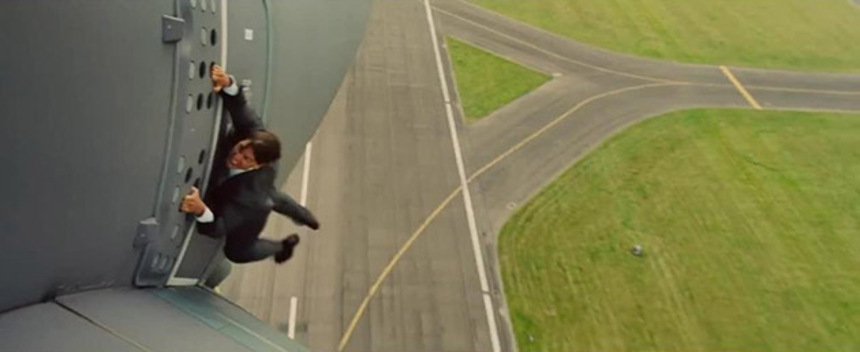Destroy All Monsters: The "It's Not CGI" Lie

Bless Tom Cruise for clambering up the outside of an escaping cargo plane in the breathless opening minutes of Mission Impossible: Rogue Nation. Bless him, too, for taking to the internet a week or two ago to assure us that Yes, It's True, I Was Outside That Plane.
In the twenty-ish years since the first Mission: Impossible - wherein Cruise definitely did not clamber up the outside of an escaping bullet train, as the impressionistic digital chatter of his flapping white dress shirt convincingly assured us - we'd be forgiven for thinking that anything that looks nuts on a cinema screen was probably too nuts to have been shot for real. Once in a while, it's nice to have our illusions shattered, especially if those illusions are about illusions themselves.
Rogue Nation is one of two blockbusters this summer whose audience interest is being enhanced by an informal secondary marketing campaign along the lines of No Really, We Shot This. The first was Mad Max: Fury Road, where the Doof's guitar really did spit fire, and many a fine motor vehicle really did flip end over end in the Namibian desert.
Mad Max and Rogue Nation also presage the big No Really, We Shot This movie of 2015, JJ Abrams' Star Wars: The Force Awakens, which takes place in a galaxy far, far away and yet has had its fan credibility pre-emptively bolstered by assurances along the lines of "we built literally everything and it all absolutely works*, no really, the prequels sucked cuz CGI."
(*citation needed)
It's all basically horseshit. The fact that a bunch of props, droids, and aliens were developed practically for The Force Awakens has as much to do with the total matrix of its production approach as the fact that a bunch of CGI techniques were piloted for The Phantom Menace.
The Phantom Menace was also one of the biggest practical effects movies of all time, using models and miniatures on a scale that was a powers-of-ten dwarfing of the original Star Wars; and guess what, there will be CGI in pretty much every single shot of The Force Awakens, too, just like there isn't one shot in Fury Road that hasn't been substantially digitally manipulated. This is the way we make movies now.
What's changed, and what interests me about it, is that the way we sell movies now seems to have finally arced back away from visual effects, after a long, elliptical orbit where the "cinema of attractions" was effects-driven for the better part of fifty years.
As recently as a decade ago, the fact that Gollum was giving such an identifiably interesting performance and was a special effect to boot was novel enough to be an equal fascination upon both of those lines; no one, though, wasted any column inches on consideration on Avengers 2's Ultron as a visual effect, in which category he was certainly a much better one than Gollum.
No, thankfully, we've arrived at the point where each element of these fantastical films can be considered sui generis, which in Ultron's case was simply: did we give a shit about him as a character? How was Spader's performance working? How was the writing? The sorts of things these filmmaking tools, theoretically, were always striving towards: not a visual invisibility, but a conceptual one.
This marks a major turning point.
I'm reading a great book right now by Julie Turnock called Plastic Reality, which looks at how the aesthetic of photorealism was developed for visual effects (with Star Wars and Close Encounters of the Third Kind as its primary examples). It was the first source that pointed out to me that photorealism is no more the "default" for how special effects can operate than it's the default for how, say, paintings are required to look; it's just a choice so overwhelmingly popular in the past four decades of cinema that it's essentially written the rulebook for how we, as viewers, interpret the images we see.
"Realistic" in special effects, in other words, is an achievement we only award if what we are looking at seems to be something that a camera might actually have photographed, even if that premise itself is utterly preposterous. Let's leave aside the fact that X-Wing fighters don't exist and could therefore never, ever be filmed; even more earthbound examples apply. No camera ever survived a 300-foot freefall with an active explosive, a la Pearl Harbour, and yet with the right amount of camera shake and lens flare we'll say that the shot looks "realistic."
But Turnock also argues that the effects of Star Wars and CE3K were simultaneously designed to be "realistic" while also being intentionally "spectacular," a value-add for the audience who would pay to see a movie whose visuals were eye-poppingly supernatural while still remaining, completely paradoxically, realistic.
This model was still in effect as recently as Avatar but may have finally bled itself dry over the course of this decade. Is it fair to say we no longer notice visual effects, unless they're bad? Has the spectacular finally been reduced to a normal, unspectacular part of any moviegoing experience?
This is what I find so funny about films like Rogue Nation and Mad Max who go so far out of their way to market themselves on the "reality" of their content, even if the claims are patently false. There's something charming about the fact that we finally hit the top of the scale on improbable visuals and had to come back down to probable ones. No, Ultron ain't interesting... but dangling a moviestar on the outside of a cargo plane? That's just crazy enough to work.
Destroy All Monsters is a weekly column on Hollywood and pop culture. Matt Brown is in Toronto and on twitter.







